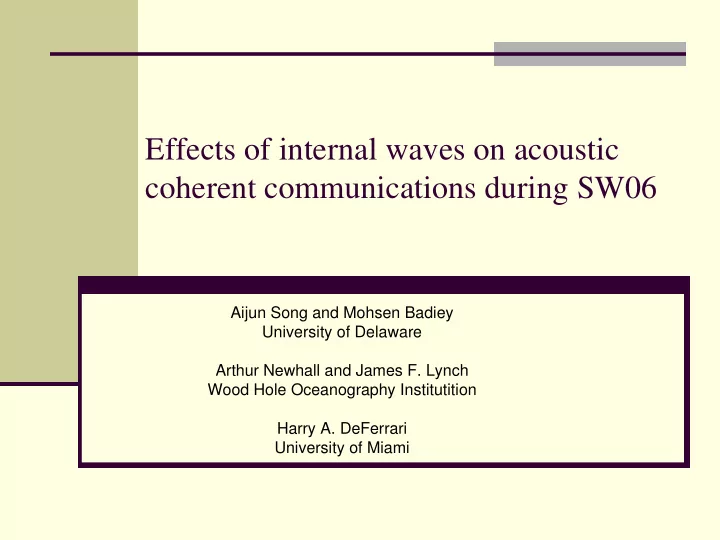

Effects of internal waves on acoustic coherent communications during SW06 Aijun Song and Mohsen Badiey University of Delaware Arthur Newhall and James F. Lynch Wood Hole Oceanography Institutition Harry A. DeFerrari University of Miami
Introduction Internal wave effects on acoustic signals (Apel, et al. , JOE1997) Intensity fluctuation (Badiey, et al. , JASA2005, JASA2007) Temporal coherency variation (Rouseff et al. , JASA2002, Yoo, JOE2005) Internal wave effects on underwater acoustic communications Expected effects but limited results in the literature Current efforts: 1) concurrent acoustic and environmental measurement; 2) using our time reversal based receiver, 3) the extent of the effects
Experimental setting Internal wave event # 50: 18:00 (GMT) Aug 17 to 06:00 Aug 18, 2006 Source: MSM Receiver: WHOI-VLA Range: about 20 km Water depth: about 80 m Acoustic signal: ~90 s M-sequences (BPSK signals) at carrier frequencies 813 Hz and 1627 Hz Source level: 186 dB re 1 micro Pa at 1 m Trans. Schedule: Every 30 min
Radar image
Water temperature profiles
Two environmental conditions 18:00: Internal waves had not reached the acoustic track (about 10 km away from the acoustic track) 22:30: Internal waves overlap the acoustic track
Receiver structure At the source, the transmitted signal in the baseband form is: å = - x t ( ) x n g t ( ) ( nT ) n The channel impulse response (CIR) function: dispersive (multipath), time varying ( ) ( , ) i h t t At the i-th element of the receiver: ( ) i = * ( ) i + y ( ) t x t ( ) h ( , ) t v t ( ) t
Receiver structure Frequent channel estimation Soft output signal-to-noise ratio (SNR) of the decision- feedback equalizer (DFE) is the performance metric
Receiver design: Presented in A. Song, M. Badiey, H.-C. Song, W. S. Hodgkiss, M. B. Porter and the KauaiEx group, JASA2008, but without Doppler correction Can achieve robust high data rate communications under dynamic ocean environments Comparison with other time reversal/DFE methods (Edelmann, et al. , JOE2005, T. C. Yang, JOE2005, H.-C. Song, et al. , JASA2006) Frequent channel estimation
Receiver parameters Key parameter: channel update internal Choose channel update interval: Depending on the fluctuating rate of the channel: Fast fluctuating channels require small channel update interval
CIR function: 813 Hz No internal waves(1800) With internal waves(2230) cir_800hz
10 km 80 km
Channel update interval for 813 Hz
CIR function: 1627 Hz No internal waves(1800) With internal waves(2230) cir_1600hz
Channel update interval for 1627 Hz
For 800 Hz carrier frequency: Without internal waves, channel estimation can be performed every 8 s without loss of performance With internal waves, channel estimation needs to be performed every 1 s For 1627 Hz carrier frequency Channel estimation needs to be performed every 250 ms regardless the internal wave condition
Channel update interval: 250 ms Frequency dependency
Summary and future work Concurrent acoustic measurements and environmental observations Significant internal wave effects on coherent underwater acoustic communications during a 12 h period at 813 Hz and 1627 Hz Receiver parameters can be depended on the environment condition and the carrier frequency Frequency dependency of the internal wave effects Acoustic modeling will be performed to explain the internal wave effects
Recommend
More recommend